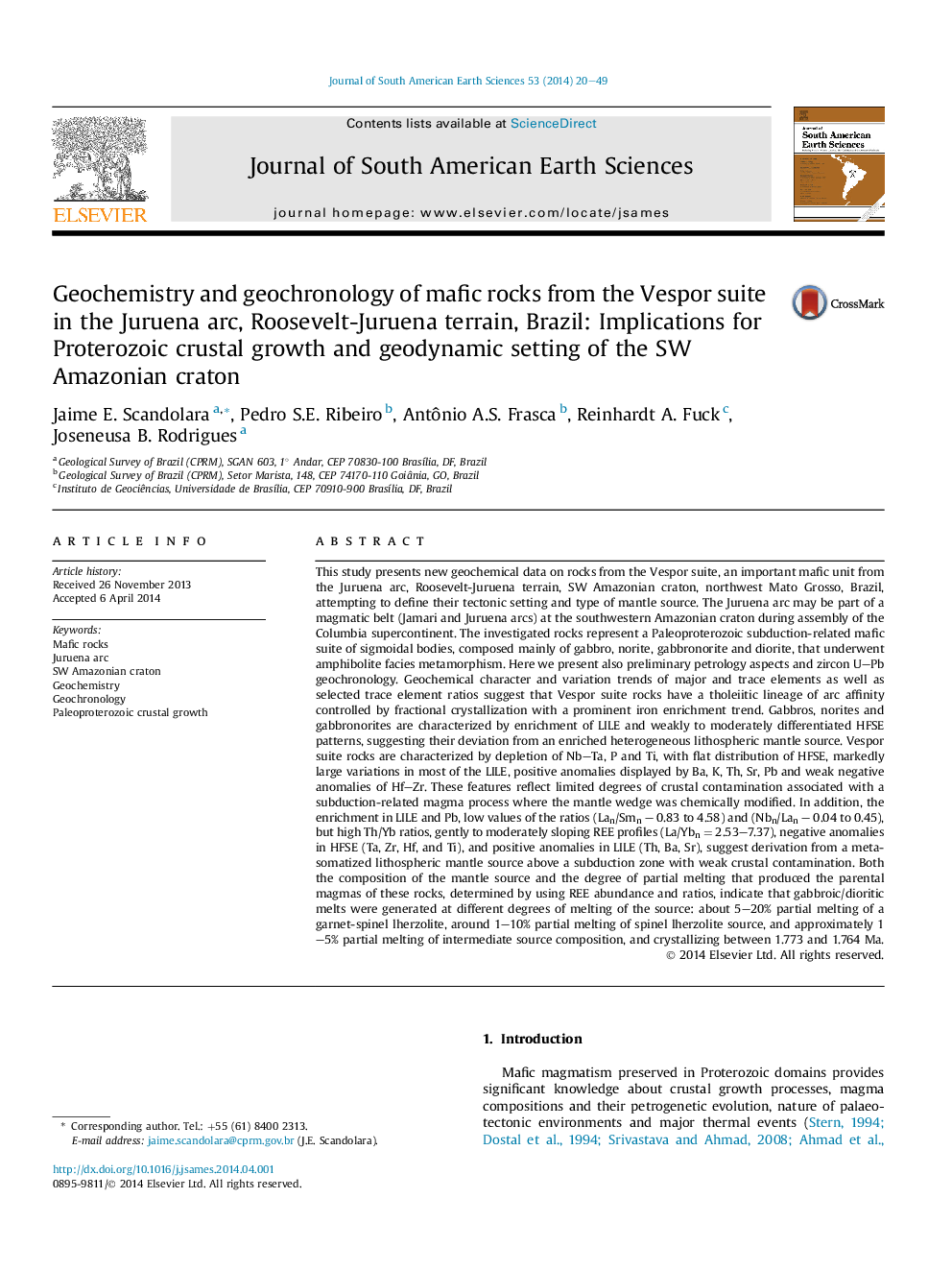| کد مقاله | کد نشریه | سال انتشار | مقاله انگلیسی | نسخه تمام متن |
|---|---|---|---|---|
| 4682280 | 1635156 | 2014 | 30 صفحه PDF | دانلود رایگان |

• We discussed isotopic and elemental geochemical signature of the Vespor suite.
• Are gabbro, norite, gabbronorite and diorite with metamorphism in amphibolite facies.
• These rocks are part of the Juruena arc, Andean-type arc, SW Amazonian craton.
• Petrogenetic processes and sources of mafic arc-related rocks in SW Amazonian craton.
• The authors discuss mantle metasomatism, slab contribution and crustal contamination.
This study presents new geochemical data on rocks from the Vespor suite, an important mafic unit from the Juruena arc, Roosevelt-Juruena terrain, SW Amazonian craton, northwest Mato Grosso, Brazil, attempting to define their tectonic setting and type of mantle source. The Juruena arc may be part of a magmatic belt (Jamari and Juruena arcs) at the southwestern Amazonian craton during assembly of the Columbia supercontinent. The investigated rocks represent a Paleoproterozoic subduction-related mafic suite of sigmoidal bodies, composed mainly of gabbro, norite, gabbronorite and diorite, that underwent amphibolite facies metamorphism. Here we present also preliminary petrology aspects and zircon U–Pb geochronology. Geochemical character and variation trends of major and trace elements as well as selected trace element ratios suggest that Vespor suite rocks have a tholeiitic lineage of arc affinity controlled by fractional crystallization with a prominent iron enrichment trend. Gabbros, norites and gabbronorites are characterized by enrichment of LILE and weakly to moderately differentiated HFSE patterns, suggesting their deviation from an enriched heterogeneous lithospheric mantle source. Vespor suite rocks are characterized by depletion of Nb–Ta, P and Ti, with flat distribution of HFSE, markedly large variations in most of the LILE, positive anomalies displayed by Ba, K, Th, Sr, Pb and weak negative anomalies of Hf–Zr. These features reflect limited degrees of crustal contamination associated with a subduction-related magma process where the mantle wedge was chemically modified. In addition, the enrichment in LILE and Pb, low values of the ratios (Lan/Smn – 0.83 to 4.58) and (Nbn/Lan – 0.04 to 0.45), but high Th/Yb ratios, gently to moderately sloping REE profiles (La/Ybn = 2.53–7.37), negative anomalies in HFSE (Ta, Zr, Hf, and Ti), and positive anomalies in LILE (Th, Ba, Sr), suggest derivation from a metasomatized lithospheric mantle source above a subduction zone with weak crustal contamination. Both the composition of the mantle source and the degree of partial melting that produced the parental magmas of these rocks, determined by using REE abundance and ratios, indicate that gabbroic/dioritic melts were generated at different degrees of melting of the source: about 5–20% partial melting of a garnet-spinel lherzolite, around 1–10% partial melting of spinel lherzolite source, and approximately 1–5% partial melting of intermediate source composition, and crystallizing between 1.773 and 1.764 Ma.
Journal: Journal of South American Earth Sciences - Volume 53, August 2014, Pages 20–49